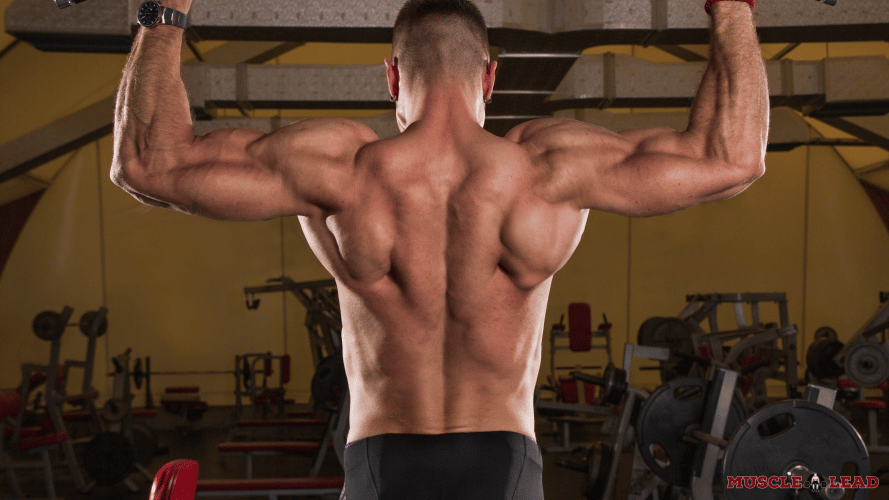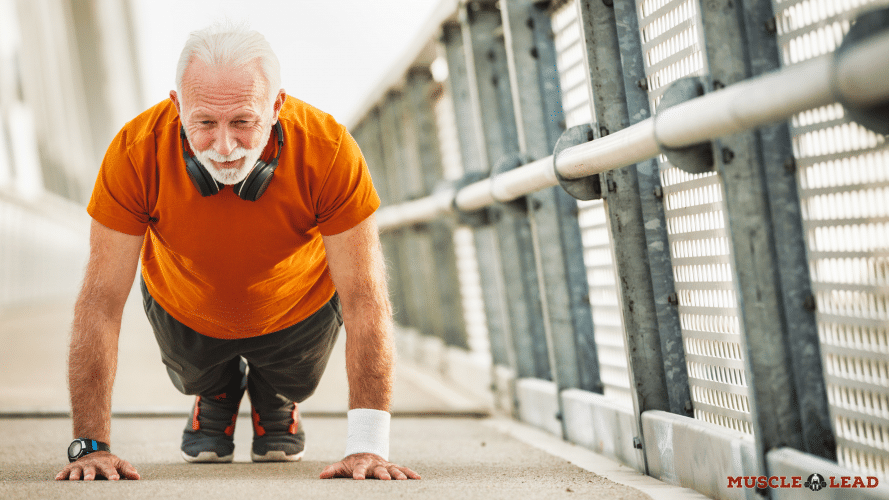I remember when I first started working out, I almost never did deadlifts.
As soon as I included it into my workout program my trapezius (traps) accelerated in strength and growth.
I kid you not, within 3 months it got to the point where my back was literally hugging against my t-shirts.
I was in utter SHOCK! Because I tried and tried, but No matter how many back rows I did, I was never able to get to that same level of muscularity.
So do deadlifts work your traps? Absolutely! Deadlift does work your lower, middle, and upper traps. The traps help stabilize the shoulders and retract the scapula during the deadlift. You will notice powerlifters tend to have larger traps due to their impressive deadlifts.
What are the Trap Muscles?
For those who do not have a proper understanding of the traps, these are the upper back muscles. The traps are broken into 3 parts. (1)
I have highlighted each part of the traps below.

Lower Traps
The lower traps are located at the bottom of the shoulder blade. It has many movement actions, but the main ones are pulling the shoulder blades downwards and offering some stability.
Middle Traps
This is the chunky middle part of the back. It is found at the middle of the shoulder blades. The most important role of the middle traps in general, is pinning the shoulder blades backwards and offering stability.
Upper Traps
The upper traps are positioned at the top of the shoulder blades and around the neck. These are the most visible from the front of the trunk.
The upper traps also stabilize the shoulder blades and shrug the shoulders upwards.
Do Deadlifts Work the Traps?
The deadlift is basically a 4 part movement.
We have an ankle, knee and hip movement. This chain of movements hit the calves, quadriceps and glutes.
The fourth movement of the deadlift is where it starts getting interesting. We will find a scapular movement, better understood as the shoulder blades.
Essentially, this is the final movement to complete the lift, just before dropping the bar back onto the ground.
But do deadlifts work the traps? Yes! It works the traps.
Now let’s get into more detail and break down each trap movement during the deadlift.
Scapular Retraction
So this is basically the fancy anatomy term for squeezing the shoulder blades together.
Towards the end of the deadlift, a lifter would perform scapular retraction. This hits the middle of the traps, known as the meat of the back.
Scapular Elevation
Another movement that we see is scapula elevations. This is where we shrug the shoulder blades slightly, at the same time as squeezing them.
Like the dumbbell shrugs, this movement would work the upper traps. Quite possibly a way to bring out that high trap tough guy look that is so desired amongst ‘gym rats’.
Scapular Depression
While setting up we depress the shoulder blades. This basically is another way to say sink the shoulder blades downwards.
Another part is when we bring the bar down just before dropping it back to the ground.
This downward shoulder blade movement targets the lower traps. (2)
8 Benefits of Working Traps from the Deadlift
As practitioners, we are always looking for transferability. Basically, how an exercise can build up something else.
Building up the traps from the deadlift may have a strong element of transferability as mentioned below.
1. Muscular Hypertrophy
The fourth part of the deadlift lift may trigger fast twitch muscle fibers (2) that were yet to be tapped into.
There is a higher possibility of this, if you are ripping some heavy weights at higher intensities.
Over the long halt, we could very well see the traps becoming larger and more defined.
It could even give that bit of extra overload that the back needed to make more gains if you hit a plateau.
2. Strength Developments
Here we can see some exercise transferability. The deadlift could quite possibly make other pulling based lifts stronger.
This is from strengthening the scapular retraction, elevation, and depression movements. (2)
I have highlighted a number of pulling based exercises, where a lifter could get better.
- Rack Pulls
- Barbell back row
- Reverse grip barbell row
- Dumbbell back row
- Upright row
- Barbell shrugs
- Dumbbell shrugs
- Dumbbell flyes
Rack Pull vs Deadlifts: Which is Better for You?
3. Postural Alignment
At times, many of us present a poor posture. This could look like the upper back hunched with the shoulders rolled forward.
This typically occurs from a muscle imbalance between the muscles on the back and front of the trunk.
Including the deadlift can build up the traps. In turn, this may help form a more neutral spine and shoulder position.
4. Sports Transferability
Athletes and sports participants can also reap some of the benefits of the deadlift trap action.
Do Deadlifts Increase Vertical Jump? Yes, Check out How
Being able to pull the shoulder blades in the deadlift manner may better sports like; wrestling, boxing, and weightlifting.
For example, the strong back may be important to lift an opponent in a wrestling reverse gut wrench position.
This movement would draw all of the shoulder blades movement, and trap muscle groups.
Are Wrestling Shoes Good for Lifting? Yes!
5. Improved Mobility Amongst Elderly
As we age it is perfectly normal to lose some strength and mobility in the body.
Similar to building strength, the deadlift can very well bring back more fluent movements amongst the elderly.
This is not just in the back, but the whole kinetic chain. This is the mobility starting from the feet, following through to the upper back.
Now we are not talking all out 100% max barbell deadlift, but just enough to get some movement.

In a real world setting, we could expect to see elderly; picking items off the ground, bending over, pulling items off shelves etc.
6. Improved Confidence
A lot of the time we do not actually think about this. A strong upper back and a nice upright posture can make you look and feel more confident.
Without joking, this look could help you in many areas of life.
In fact, it could quite possibly help show a good amount of confidence during;
- Interviews
- Presentations
- Meetings
- Dates
- Parties and get-togethers
7. Form a Base for Barbell Back Squats
I can not stress the IMPORTANCE of the traps during the barbell back squat enough.
To form a base to place the bar before performing the squat, we need a reasonable amount of trap muscles.
This helps to cushion the bar and stop the bar coming into contact with the upper spine.
Subsequently, building the traps from deadlift could promote a safe and effective barbell back squat.
8. Less Work Needed for ‘Back Day’
If you get enough trap stimulus from deadlift, you may not need to do as much for back day.
This could be especially useful for relatively new ‘gym goers’, who can reap those newbie trap gains.
Say a lifter could only lift once a week, the deadlift would target most of the muscles of the body.
Take Home Message
To finalize the answer, the traps sit around the center of the shoulder blades.
They stabilize the shoulder blades, along with moving them downwards, backwards and upwards.
Do deadlifts work the traps? Yes, the deadlift does work these movements during the fourth movement.
Thereby, the deadlift activates all 3 parts of the traps (lower, middle, upper).
We could think of 8 benefits of working the traps from the deadlift.
All in all, the deadlift is a lower body exercise that can be a great trap builder. Why not give it a go and reap some of the benefits?
Happy Lifting!
FAQs
Yes! Mostly in the fourth movement and just before putting the bar down.
Basically, the center upper back muscle group, broken down into lower, middle and upper parts.
YES! I look at the deadlift as a lower body exercise that also hits parts of the upper body.
Additional stimulus, resulting in more strength and muscle gains.
References
- Badura, M., Grzonkowska, M., Baumgart, M., et al. ‘Quantitative Anatomy of the Trapezius Muscle in the Human Fetus’ Advances In Clinical Experimental Medicine. 2016; 25(4):605–609
- Anderson, V., Filmland, M.S., Mo, D., et al. ‘Electromyographic comparison of barbell deadlift, hex bar deadlift, and hip thrust‘ exercises: a cross-over study’ The Journal of Strength & Conditioning Research. 2018; 32 (3): 587–593





